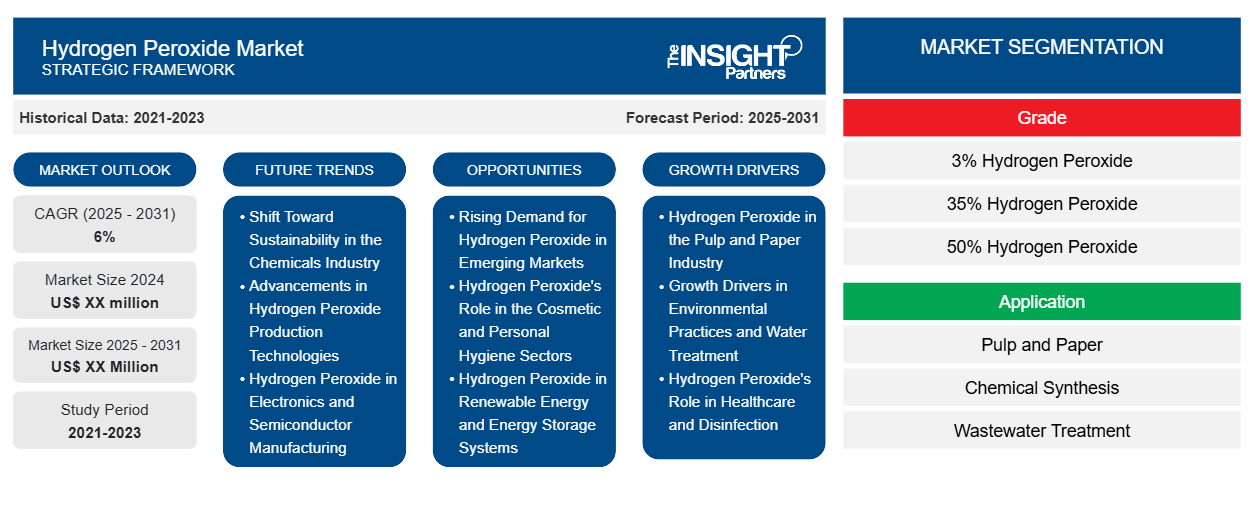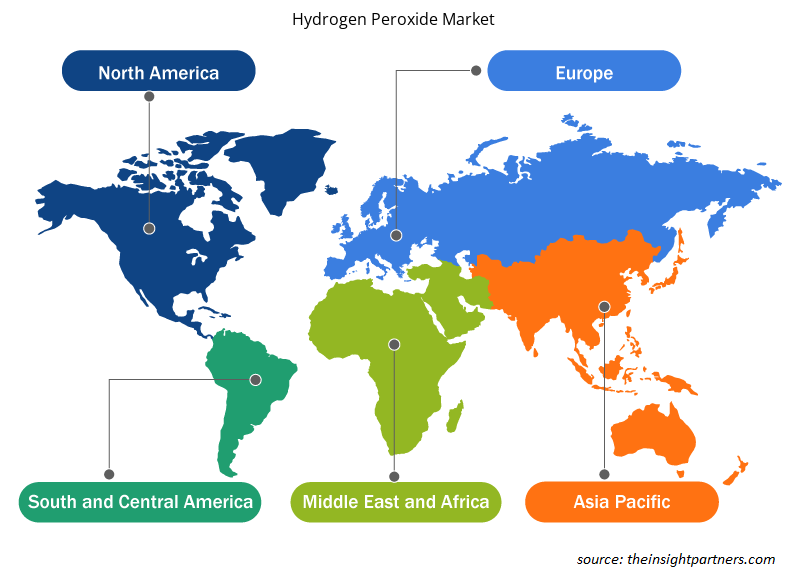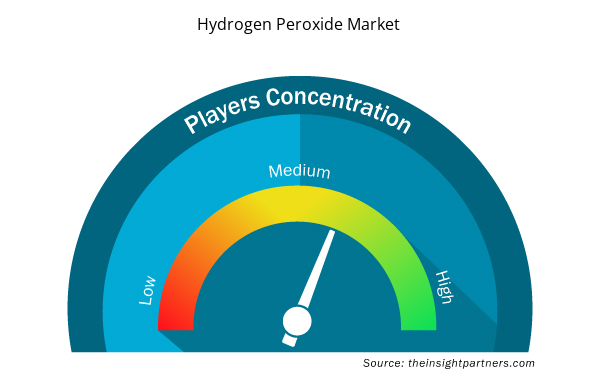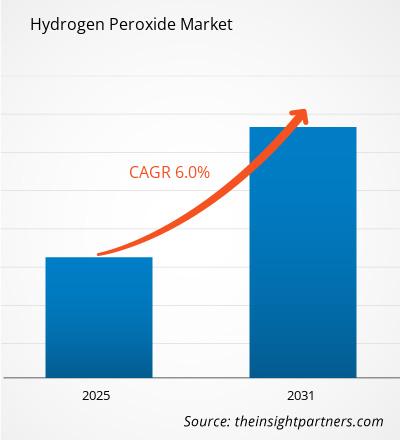Le marché du peroxyde d'hydrogène devrait enregistrer un TCAC de 6 % de 2025 à 2031, avec une taille de marché passant de XX millions de dollars américains en 2024 à XX millions de dollars américains d'ici 2031.
Le rapport sur le marché du peroxyde d'hydrogène est segmenté par qualité (peroxyde d'hydrogène à 3 %, peroxyde d'hydrogène à 35 %, peroxyde d'hydrogène à 50 %, et autres). Le marché est segmenté en fonction des applications (pâtes et papiers, synthèse chimique, traitement des eaux usées, exploitation minière, agroalimentaire, soins personnels et cosmétiques, textile, santé, et autres). L'analyse mondiale est ensuite ventilée par région et par pays. La taille et les prévisions du marché aux niveaux mondial, régional et national pour tous les segments clés sont couvertes. Le rapport présente la valeur en USD pour l'analyse, les segments, les régions et les pays susmentionnés. Il couvre les tendances du marché, ainsi que la dynamique du marché, notamment les moteurs, les freins et les principales opportunités. Il présente également une analyse du paysage industriel et de la concurrence, notamment la concentration du marché, l'analyse des cartes thermiques, les principaux acteurs et les évolutions récentes du marché.
Objet du rapport
Le rapport sur le marché du peroxyde d'hydrogène, publié par The Insight Partners, vise à décrire le paysage actuel et la croissance future, les principaux moteurs, les défis et les opportunités. Il fournira des informations aux différents acteurs du secteur, notamment :
- Fournisseurs/fabricants de technologies : pour comprendre l’évolution de la dynamique du marché et connaître les opportunités de croissance potentielles, leur permettant de prendre des décisions stratégiques éclairées.
- Investisseurs : réaliser une analyse complète des tendances concernant le taux de croissance du marché, les projections financières du marché et les opportunités qui existent tout au long de la chaîne de valeur.
- Organismes de réglementation : Réglementer les politiques et les activités de police sur le marché dans le but de minimiser les abus, de préserver la confiance des investisseurs et de maintenir l’intégrité et la stabilité du marché.
Segmentation du marché du peroxyde d'hydrogène
Grade
- Peroxyde d'hydrogène à 3 %
- Peroxyde d'hydrogène à 35 %
- 50 % de peroxyde d'hydrogène
Application
- Pâtes et papiers
- Synthèse chimique
- Traitement des eaux usées
- Exploitation minière
- Alimentation et boissons
- Soins personnels et cosmétiques
- Textile
- soins de santé
Personnalisez ce rapport en fonction de vos besoins
Vous bénéficierez d'une personnalisation gratuite de n'importe quel rapport, y compris des parties de ce rapport, ou d'une analyse au niveau des pays, d'un pack de données Excel, ainsi que de superbes offres et réductions pour les start-ups et les universités.
Marché du peroxyde d'hydrogène : perspectives stratégiques

- Obtenez les principales tendances clés du marché de ce rapport.Cet échantillon GRATUIT comprendra une analyse de données, allant des tendances du marché aux estimations et prévisions.
Facteurs de croissance du marché du peroxyde d'hydrogène
- Le peroxyde d'hydrogène dans l'industrie papetière : Le peroxyde d'hydrogène est couramment utilisé par de nombreuses industries, notamment celle des pâtes et papiers, notamment comme agent de blanchiment. Cette utilisation répond à la forte demande mondiale de produits papetiers, notamment dans les pays en développement où le besoin d'agents de blanchiment de qualité supérieure et plus sûrs s'est accru. Les agents de blanchiment sans chlore sont peu attractifs pour les utilisateurs, ce qui explique l'augmentation de l'utilisation du peroxyde d'hydrogène dans l'industrie papetière. C'est également l'une des raisons de la demande croissante de peroxyde d'hydrogène, car les producteurs de cette industrie recherchent des agents de blanchiment efficaces et respectueux de l'environnement.
- Moteurs de croissance des pratiques environnementales et du traitement de l'eau : Perspectives de croissance – Selon le dernier rapport, la croissance de ce marché, notamment dans les pays émergents et les régions en développement, devrait provenir de l'attention portée à l'amélioration des procédés de traitement de l'eau. Par ailleurs, on observe une augmentation des projets industriels et une application accrue de la législation environnementale. Le peroxyde d'hydrogène est un produit chimique utilisé dans de nombreux ménages et entreprises, mais il est principalement utilisé dans des pratiques environnementales telles que la gestion des déchets, où il agit comme oxydant pour traiter les déchets industriels et les débarrasser des matières dangereuses. Il est également utilisé dans les processus de décontamination, contribuant ainsi à la recherche d'un environnement propre. La pollution croissante de l'eau et l'application de lois environnementales strictes ont favorisé l'émergence du marché du peroxyde d'hydrogène, car ce produit chimique est nécessaire au traitement de l'eau des piscines et aux processus de nettoyage de l'environnement.
- Rôle du peroxyde d'hydrogène dans les soins de santé et la désinfection : L'utilisation du peroxyde d'hydrogène dans le secteur pharmaceutique, ainsi que dans d'autres secteurs, a été largement adoptée, notamment en cette période de crise de la COVID-19, grâce à ses capacités de désinfection. Les établissements de santé tels que les hôpitaux, les cliniques et autres acteurs du système de santé sont connus pour utiliser le peroxyde d'hydrogène pour nettoyer les surfaces, les équipements et la stérilisation des procédures médicales. C'est pourquoi il est privilégié pour le nettoyage et la désinfection des surfaces par rapport à toute autre substance dotée d'une activité antimicrobienne aussi puissante, notamment en cas de toxicité modérée. Ce fut particulièrement le cas lors de la toute première vague de l'épidémie et par la suite, lorsque des niveaux de propreté très élevés étaient requis.
Tendances futures du marché du peroxyde d'hydrogène
- Évolution vers le développement durable dans l'industrie chimique : L'industrie chimique a récemment pris un virage vers le développement durable, adoptant des alternatives propres et écologiques en remplacement des méthodes traditionnelles. Elle est considérée comme plus sûre que la plupart des substances chimiques utilisées dans l'industrie, car l'eau et l'oxygène, produits finaux de la décomposition du peroxyde d'hydrogène, sont considérés comme des agents oxydants non toxiques. La plupart des secteurs étant axés sur le respect de l'environnement et la réduction des niveaux de pollution, la consommation de peroxyde d'hydrogène devrait maintenir une courbe de croissance régulière dans les années à venir, notamment pour le blanchiment, l'assainissement de l'eau et la fabrication de précurseurs de la chimie verte.
- Progrès dans les technologies de production de peroxyde d'hydrogène : Le procédé de production de peroxyde d'hydrogène a toujours été gourmand en énergie et en ressources, et a privilégié le procédé à l'anthraquinone. Cependant, de nouvelles approches récentes ont permis d'améliorer la production et l'efficacité énergétique de ce procédé. De nombreuses technologies de production avancées, telles que la synthèse directe et d'autres procédés économiques et respectueux de l'environnement, sont sous-exploitées. Ces nouvelles technologies devraient permettre de produire du peroxyde d'hydrogène à un prix abordable et donc d'accroître son utilisation dans plusieurs autres domaines.
- Le peroxyde d'hydrogène dans la fabrication de l'électronique et des semi-conducteurs : Les secteurs de l'électronique et des semi-conducteurs sont considérés comme de nouveaux débouchés pour le peroxyde d'hydrogène, notamment pour le nettoyage et la gravure. Le film poreux constitué d'oxyde d'aluminium peut être nettoyé au peroxyde d'hydrogène lors du découpage des plaquettes de silicium afin d'éliminer les résidus organiques et les impuretés. Face à la demande croissante en dispositifs électroniques, notamment dans la région Asie-Pacifique, l'utilisation du peroxyde d'hydrogène dans l'industrie devrait croître. Par conséquent, la complexité et la miniaturisation croissantes des dispositifs électroniques créeront de nouvelles applications nécessitant des procédés de nettoyage efficaces, ce qui entraînera une consommation accrue de peroxyde d'hydrogène.
Opportunités du marché du peroxyde d'hydrogène
- Demande croissante de peroxyde d'hydrogène sur les marchés émergents : La demande de peroxyde d'hydrogène devrait connaître une forte hausse sur les marchés émergents, notamment en Asie-Pacifique, en Amérique latine et en Afrique. En raison de cette tendance à l'industrialisation et à l'urbanisation, et de l'augmentation des activités dans les secteurs du textile, du papier et du traitement des eaux, des opportunités s'offrent aux fournisseurs de peroxyde d'hydrogène dans ces régions. De plus, grâce à l'augmentation des activités industrielles et à l'application de lois environnementales strictes, les entreprises capables de fournir des produits et services adaptés à ces marchés sont susceptibles de conquérir de plus grandes parts de marché.
- Rôle du peroxyde d'hydrogène dans les secteurs des cosmétiques et de l'hygiène personnelle : Les industries des cosmétiques et de l'hygiène personnelle utilisent fréquemment le peroxyde d'hydrogène pour l'épilation, le blanchiment des dents, le nettoyage, etc. Avec l'augmentation des consommateurs soucieux de la sécurité et de la composition des produits de soins personnels, l'utilisation du peroxyde d'hydrogène trouvera son essor dans des formulations plus naturelles et biologiques. L'utilisation du peroxyde d'hydrogène dans les produits cosmétiques tels que les soins de la peau et l'hygiène bucco-dentaire se développera également, le marché continuant de s'orienter vers des produits axés sur le bien-être et l'hygiène. Les entreprises capables de concevoir et de fabriquer des produits de soins personnels contenant du peroxyde d'hydrogène, sûrs et écologiques, seront bien placées pour exploiter ce marché de niche émergent.
- Peroxyde d'hydrogène dans les énergies renouvelables et les systèmes de stockage d'énergie : L'optimisme des prix des systèmes de stockage d'énergie et des piles à combustible rend son utilisation possible, permettant ainsi d'exploiter une part importante du marché des énergies renouvelables. Son application aux batteries métal-air est également à l'étude ; ces dispositifs se caractérisent par une densité énergétique et une durée de vie supérieures à celles des batteries classiques. Compte tenu des avancées actuelles dans les nombreux nouveaux systèmes de production d'électricité et de stockage d'énergie, les perspectives d'utilisation du peroxyde d'hydrogène dans l'économie s'élargissent encore, notamment si cette utilisation est intégrée aux technologies disponibles et futures visant à éliminer ou à réduire la dépendance de l'homme aux combustibles fossiles.
Aperçu régional du marché du peroxyde d'hydrogène
Les tendances et facteurs régionaux influençant le marché du peroxyde d'hydrogène tout au long de la période de prévision ont été analysés en détail par les analystes d'Insight Partners. Cette section aborde également les segments et la géographie du marché du peroxyde d'hydrogène en Amérique du Nord, en Europe, en Asie-Pacifique, au Moyen-Orient et en Afrique, ainsi qu'en Amérique du Sud et en Amérique centrale.

- Obtenez les données régionales spécifiques au marché du peroxyde d'hydrogène
Portée du rapport sur le marché du peroxyde d'hydrogène
| Attribut de rapport | Détails |
|---|---|
| Taille du marché en 2024 | XX millions de dollars américains |
| Taille du marché d'ici 2031 | XX millions de dollars américains |
| TCAC mondial (2025 - 2031) | 6% |
| Données historiques | 2021-2023 |
| Période de prévision | 2025-2031 |
| Segments couverts | Par niveau
|
| Régions et pays couverts | Amérique du Nord
|
| Leaders du marché et profils d'entreprises clés |
|
Densité des acteurs du marché du peroxyde d'hydrogène : comprendre son impact sur la dynamique des entreprises
Le marché du peroxyde d'hydrogène connaît une croissance rapide, portée par une demande croissante des utilisateurs finaux, due à des facteurs tels que l'évolution des préférences des consommateurs, les avancées technologiques et une meilleure connaissance des avantages du produit. Face à cette demande croissante, les entreprises élargissent leur offre, innovent pour répondre aux besoins des consommateurs et capitalisent sur les nouvelles tendances, ce qui alimente la croissance du marché.
La densité des acteurs du marché désigne la répartition des entreprises opérant sur un marché ou un secteur particulier. Elle indique le nombre de concurrents (acteurs) présents sur un marché donné par rapport à sa taille ou à sa valeur marchande totale.
Les principales entreprises opérant sur le marché du peroxyde d'hydrogène sont :
- Akzonobel NV
- Arkema SA
- BASF SE
- Ecolab Inc. (Société Nalco)
- Evonik Industries AG
Avertissement : Les entreprises répertoriées ci-dessus ne sont pas classées dans un ordre particulier.

- Obtenez un aperçu des principaux acteurs du marché du peroxyde d'hydrogène
Principaux arguments de vente
- Couverture complète : Le rapport couvre de manière exhaustive l’analyse des produits, des services, des types et des utilisateurs finaux du marché du peroxyde d’hydrogène, offrant un paysage holistique.
- Analyse d’experts : Le rapport est compilé sur la base d’une compréhension approfondie des experts et analystes du secteur.
- Informations à jour : Le rapport garantit la pertinence commerciale en raison de sa couverture des informations récentes et des tendances des données.
- Options de personnalisation : ce rapport peut être personnalisé pour répondre aux exigences spécifiques des clients et s'adapter de manière appropriée aux stratégies commerciales.
Le rapport de recherche sur le marché du peroxyde d'hydrogène peut donc contribuer à décrypter et à comprendre le contexte et les perspectives de croissance du secteur. Malgré quelques inquiétudes légitimes, les avantages globaux de ce rapport tendent à l'emporter sur ses inconvénients.
- Analyse historique (2 ans), année de base, prévision (7 ans) avec TCAC
- Analyse PEST et SWO
- Taille du marché Valeur / Volume - Mondial, Régional, Pays
- Industrie et paysage concurrentiel
- Ensemble de données Excel


- Photo Editing Software Market
- Ceiling Fans Market
- Pharmacovigilance and Drug Safety Software Market
- Microcatheters Market
- Pressure Vessel Composite Materials Market
- Industrial Inkjet Printers Market
- Cling Films Market
- Adaptive Traffic Control System Market
- Foot Orthotic Insoles Market
- Biopharmaceutical Tubing Market

Report Coverage
Revenue forecast, Company Analysis, Industry landscape, Growth factors, and Trends

Segment Covered
This text is related
to segments covered.

Regional Scope
North America, Europe, Asia Pacific, Middle East & Africa, South & Central America

Country Scope
This text is related
to country scope.
Questions fréquemment posées
Focus on sustainable and green chemistry is expected to be the key market trends.
Based on application, the wastewater treatment segment is expected to witness the fastest growth during the forecast period.
Based on geography, Asia Pacific held the largest share of the hydrogen peroxide market due to the strong growth of the wastewater treatment and paper and pulp industry in the region.
Rising demand from the pulp and paper industry is driving the market growth.
Solvay SA, Evonik Industries, Arkema, National Peroxide Ltd, Kemira, Aditya Birla Chemicals, Airedale Group, Mitsubishi Gas Chemical Company, Gujrat Alkalies and Chemicals Ltd, and OCI Company Ltd are the key players operating in the hydrogen peroxide market.
The Hydrogen Peroxide Market is estimated to witness a CAGR of 6% from 2023 to 2031
Trends and growth analysis reports related to Chemicals and Materials : READ MORE..
1. Akzonobel N.V.
2. Arkema SA
3. BASF SE
4. Ecolab Inc. (Nalco Company)
5. Evonik Industries AG
6. Kemira OYJ
7. Merck Group
8. Mitsubishi Gas Chemical Company
9. Solvay SA
10. The DOW Chemical Company
The Insight Partners performs research in 4 major stages: Data Collection & Secondary Research, Primary Research, Data Analysis and Data Triangulation & Final Review.
- Data Collection and Secondary Research:
As a market research and consulting firm operating from a decade, we have published and advised several client across the globe. First step for any study will start with an assessment of currently available data and insights from existing reports. Further, historical and current market information is collected from Investor Presentations, Annual Reports, SEC Filings, etc., and other information related to company’s performance and market positioning are gathered from Paid Databases (Factiva, Hoovers, and Reuters) and various other publications available in public domain.
Several associations trade associates, technical forums, institutes, societies and organization are accessed to gain technical as well as market related insights through their publications such as research papers, blogs and press releases related to the studies are referred to get cues about the market. Further, white papers, journals, magazines, and other news articles published in last 3 years are scrutinized and analyzed to understand the current market trends.
- Primary Research:
The primarily interview analysis comprise of data obtained from industry participants interview and answers to survey questions gathered by in-house primary team.
For primary research, interviews are conducted with industry experts/CEOs/Marketing Managers/VPs/Subject Matter Experts from both demand and supply side to get a 360-degree view of the market. The primary team conducts several interviews based on the complexity of the markets to understand the various market trends and dynamics which makes research more credible and precise.
A typical research interview fulfils the following functions:
- Provides first-hand information on the market size, market trends, growth trends, competitive landscape, and outlook
- Validates and strengthens in-house secondary research findings
- Develops the analysis team’s expertise and market understanding
Primary research involves email interactions and telephone interviews for each market, category, segment, and sub-segment across geographies. The participants who typically take part in such a process include, but are not limited to:
- Industry participants: VPs, business development managers, market intelligence managers and national sales managers
- Outside experts: Valuation experts, research analysts and key opinion leaders specializing in the electronics and semiconductor industry.
Below is the breakup of our primary respondents by company, designation, and region:

Once we receive the confirmation from primary research sources or primary respondents, we finalize the base year market estimation and forecast the data as per the macroeconomic and microeconomic factors assessed during data collection.
- Data Analysis:
Once data is validated through both secondary as well as primary respondents, we finalize the market estimations by hypothesis formulation and factor analysis at regional and country level.
- Macro-Economic Factor Analysis:
We analyse macroeconomic indicators such the gross domestic product (GDP), increase in the demand for goods and services across industries, technological advancement, regional economic growth, governmental policies, the influence of COVID-19, PEST analysis, and other aspects. This analysis aids in setting benchmarks for various nations/regions and approximating market splits. Additionally, the general trend of the aforementioned components aid in determining the market's development possibilities.
- Country Level Data:
Various factors that are especially aligned to the country are taken into account to determine the market size for a certain area and country, including the presence of vendors, such as headquarters and offices, the country's GDP, demand patterns, and industry growth. To comprehend the market dynamics for the nation, a number of growth variables, inhibitors, application areas, and current market trends are researched. The aforementioned elements aid in determining the country's overall market's growth potential.
- Company Profile:
The “Table of Contents” is formulated by listing and analyzing more than 25 - 30 companies operating in the market ecosystem across geographies. However, we profile only 10 companies as a standard practice in our syndicate reports. These 10 companies comprise leading, emerging, and regional players. Nonetheless, our analysis is not restricted to the 10 listed companies, we also analyze other companies present in the market to develop a holistic view and understand the prevailing trends. The “Company Profiles” section in the report covers key facts, business description, products & services, financial information, SWOT analysis, and key developments. The financial information presented is extracted from the annual reports and official documents of the publicly listed companies. Upon collecting the information for the sections of respective companies, we verify them via various primary sources and then compile the data in respective company profiles. The company level information helps us in deriving the base number as well as in forecasting the market size.
- Developing Base Number:
Aggregation of sales statistics (2020-2022) and macro-economic factor, and other secondary and primary research insights are utilized to arrive at base number and related market shares for 2022. The data gaps are identified in this step and relevant market data is analyzed, collected from paid primary interviews or databases. On finalizing the base year market size, forecasts are developed on the basis of macro-economic, industry and market growth factors and company level analysis.
- Data Triangulation and Final Review:
The market findings and base year market size calculations are validated from supply as well as demand side. Demand side validations are based on macro-economic factor analysis and benchmarks for respective regions and countries. In case of supply side validations, revenues of major companies are estimated (in case not available) based on industry benchmark, approximate number of employees, product portfolio, and primary interviews revenues are gathered. Further revenue from target product/service segment is assessed to avoid overshooting of market statistics. In case of heavy deviations between supply and demand side values, all thes steps are repeated to achieve synchronization.
We follow an iterative model, wherein we share our research findings with Subject Matter Experts (SME’s) and Key Opinion Leaders (KOLs) until consensus view of the market is not formulated – this model negates any drastic deviation in the opinions of experts. Only validated and universally acceptable research findings are quoted in our reports.
We have important check points that we use to validate our research findings – which we call – data triangulation, where we validate the information, we generate from secondary sources with primary interviews and then we re-validate with our internal data bases and Subject matter experts. This comprehensive model enables us to deliver high quality, reliable data in shortest possible time.

 Obtenez un échantillon gratuit pour ce rapport
Obtenez un échantillon gratuit pour ce rapport